9e97fd4f427e65c126cb263432a75b64.ppt
- Количество слайдов: 62
 The Mechanical Generation of Fault Trees for State Transition Systems Richard Banach School of Computer Science, University of Manchester, UK Marco Bozzano Fondazione Bruno Kessler, FBK-IRST, Trento, Italy R. Banach, School of Computer Science, University of Manchester, UK M. Bozzano, Fondazione Bruno Kessler, FBK-IRST, Trento, Italy 1
The Mechanical Generation of Fault Trees for State Transition Systems Richard Banach School of Computer Science, University of Manchester, UK Marco Bozzano Fondazione Bruno Kessler, FBK-IRST, Trento, Italy R. Banach, School of Computer Science, University of Manchester, UK M. Bozzano, Fondazione Bruno Kessler, FBK-IRST, Trento, Italy 1
 Contents: 1. Overview of FTA. 2. Model-Based Safety Analysis. 3. The FSAP Safety Analysis Platform. 4. System Evolution and Retrenchment. 5. FT Extraction for Combinational Circuits. 6. Soundness and Completeness of FT Extraction (Overview). 7. Clocked Acyclic Circuits, Causal Relations, Retrenchments. 8. FT Extraction for Clocked Acyclic Circuits. 9. Feedback Circuits, Causal Relations, Retrenchments. 10. FT Extraction for Feedback Circuits. 11. FSAP and the Model Checking Approach to FT Extraction. 12. Retrenchment and Model Checking Compared. R. Banach, School of Computer Science, University of Manchester, UK M. Bozzano, Fondazione Bruno Kessler, FBK-IRST, Trento, Italy 2
Contents: 1. Overview of FTA. 2. Model-Based Safety Analysis. 3. The FSAP Safety Analysis Platform. 4. System Evolution and Retrenchment. 5. FT Extraction for Combinational Circuits. 6. Soundness and Completeness of FT Extraction (Overview). 7. Clocked Acyclic Circuits, Causal Relations, Retrenchments. 8. FT Extraction for Clocked Acyclic Circuits. 9. Feedback Circuits, Causal Relations, Retrenchments. 10. FT Extraction for Feedback Circuits. 11. FSAP and the Model Checking Approach to FT Extraction. 12. Retrenchment and Model Checking Compared. R. Banach, School of Computer Science, University of Manchester, UK M. Bozzano, Fondazione Bruno Kessler, FBK-IRST, Trento, Italy 2
 1. Overview of FTA. Fault Tree Analysis (FTA) is a traditional safety analysis activity. Main features: • Deductive technique. • Graphical representation of the effects of failures on system requirements. (Boolean gates to represent the logical interrelationships between events) • Widespread use in aerospace, automotive, nuclear power plants, etc. • Qualitative model that can be evaluated quantitatively. In the rest of this chapter: • Short introduction to safety analysis and FTA. • Fault tree basics. • Not an exhaustive presentation on FTA: mainly the notions needed in the rest of the tutorial will be presented. R. Banach, School of Computer Science, University of Manchester, UK M. Bozzano, Fondazione Bruno Kessler, FBK-IRST, Trento, Italy 3
1. Overview of FTA. Fault Tree Analysis (FTA) is a traditional safety analysis activity. Main features: • Deductive technique. • Graphical representation of the effects of failures on system requirements. (Boolean gates to represent the logical interrelationships between events) • Widespread use in aerospace, automotive, nuclear power plants, etc. • Qualitative model that can be evaluated quantitatively. In the rest of this chapter: • Short introduction to safety analysis and FTA. • Fault tree basics. • Not an exhaustive presentation on FTA: mainly the notions needed in the rest of the tutorial will be presented. R. Banach, School of Computer Science, University of Manchester, UK M. Bozzano, Fondazione Bruno Kessler, FBK-IRST, Trento, Italy 3
 Motivations Objectives of safety analysis: • Determine the conditions under which safety hazards can occur. • Ensure that a system meets the safety requirements that are required for its deployment and use. Particularly important for safety-critical systems, where unexpected behaviour may cause significant loss of money or human lives! Safety levels can be domain-dependent: e. g. , notion of fail-safe state in railways (all trains stopped, all signals at red), but no fail-safe state in avionics. R. Banach, School of Computer Science, University of Manchester, UK M. Bozzano, Fondazione Bruno Kessler, FBK-IRST, Trento, Italy 4
Motivations Objectives of safety analysis: • Determine the conditions under which safety hazards can occur. • Ensure that a system meets the safety requirements that are required for its deployment and use. Particularly important for safety-critical systems, where unexpected behaviour may cause significant loss of money or human lives! Safety levels can be domain-dependent: e. g. , notion of fail-safe state in railways (all trains stopped, all signals at red), but no fail-safe state in avionics. R. Banach, School of Computer Science, University of Manchester, UK M. Bozzano, Fondazione Bruno Kessler, FBK-IRST, Trento, Italy 4
 Motivations Safety analysis: • Typically needed for certification of safety-critical systems. Safety analysis must: • Analyse system behaviour under all possible operational conditions. • In particular in presence of malfunctions of its components. R. Banach, School of Computer Science, University of Manchester, UK M. Bozzano, Fondazione Bruno Kessler, FBK-IRST, Trento, Italy 5
Motivations Safety analysis: • Typically needed for certification of safety-critical systems. Safety analysis must: • Analyse system behaviour under all possible operational conditions. • In particular in presence of malfunctions of its components. R. Banach, School of Computer Science, University of Manchester, UK M. Bozzano, Fondazione Bruno Kessler, FBK-IRST, Trento, Italy 5
 Safety Analysis System Design Safety Analysis System Level Requirements Fault Hazard Analysis System Architecture PSSA System Implementation System Safety Analysis Certification Complex System R. Banach, School of Computer Science, University of Manchester, UK M. Bozzano, Fondazione Bruno Kessler, FBK-IRST, Trento, Italy 6
Safety Analysis System Design Safety Analysis System Level Requirements Fault Hazard Analysis System Architecture PSSA System Implementation System Safety Analysis Certification Complex System R. Banach, School of Computer Science, University of Manchester, UK M. Bozzano, Fondazione Bruno Kessler, FBK-IRST, Trento, Italy 6
 Safety Analysis System Design Safety Analysis System Level Requirements Fault Hazard Analysis System Architecture PSSA System Implementation Fault Tree Analysis (FTA) System Safety Analysis Failure Mode and Effects Analysis (FMEA) Probabili ty Intermediate Effect Final Effect Severity Undetected Fire in Bay Area Certification Fault 10 e-8 Subsystem A fails Loss of mechanical drive 5 … … … Complex System R. Banach, School of Computer Science, University of Manchester, UK M. Bozzano, Fondazione Bruno Kessler, FBK-IRST, Trento, Italy 7
Safety Analysis System Design Safety Analysis System Level Requirements Fault Hazard Analysis System Architecture PSSA System Implementation Fault Tree Analysis (FTA) System Safety Analysis Failure Mode and Effects Analysis (FMEA) Probabili ty Intermediate Effect Final Effect Severity Undetected Fire in Bay Area Certification Fault 10 e-8 Subsystem A fails Loss of mechanical drive 5 … … … Complex System R. Banach, School of Computer Science, University of Manchester, UK M. Bozzano, Fondazione Bruno Kessler, FBK-IRST, Trento, Italy 7
 Safety Analysis Safety Assessment carried out in parallel with system design and development. E. g. , safety assessment process model in avionics. Several safety assessment activities, e. g. : • Fault Hazard Analysis (FHA). • Event Tree Analysis. • Failure Mode and Effects Analysis (FMEA). • Fault Tree Analysis (FTA). • … Fault trees produced at different stages of safety assessment. R. Banach, School of Computer Science, University of Manchester, UK M. Bozzano, Fondazione Bruno Kessler, FBK-IRST, Trento, Italy
Safety Analysis Safety Assessment carried out in parallel with system design and development. E. g. , safety assessment process model in avionics. Several safety assessment activities, e. g. : • Fault Hazard Analysis (FHA). • Event Tree Analysis. • Failure Mode and Effects Analysis (FMEA). • Fault Tree Analysis (FTA). • … Fault trees produced at different stages of safety assessment. R. Banach, School of Computer Science, University of Manchester, UK M. Bozzano, Fondazione Bruno Kessler, FBK-IRST, Trento, Italy
 Safety Analysis An example – safety property (qualitative): • “If no more than 3 components fail, then I never have a total loss of hydraulic power”. • “No single point of failure can cause unavailability of both the primary and secondary power systems”. An example – safety property (quantitative): • “The probability of a total loss of hydraulic power is less than 10 -7”. • “The probability that both the primary and secondary power systems fail during the same mission is less than 10 -9”. R. Banach, School of Computer Science, University of Manchester, UK M. Bozzano, Fondazione Bruno Kessler, FBK-IRST, Trento, Italy 9
Safety Analysis An example – safety property (qualitative): • “If no more than 3 components fail, then I never have a total loss of hydraulic power”. • “No single point of failure can cause unavailability of both the primary and secondary power systems”. An example – safety property (quantitative): • “The probability of a total loss of hydraulic power is less than 10 -7”. • “The probability that both the primary and secondary power systems fail during the same mission is less than 10 -9”. R. Banach, School of Computer Science, University of Manchester, UK M. Bozzano, Fondazione Bruno Kessler, FBK-IRST, Trento, Italy 9
 Safety Analysis An example – Fault Tree Analysis: • “Find all combinations of basic faults which may cause total loss of hydraulic power”. Particular interest in single points of failure … more in general in minimal combinations of faults. Combination of basic faults = cut set. Minimal combination = minimal cut set. R. Banach, School of Computer Science, University of Manchester, UK M. Bozzano, Fondazione Bruno Kessler, FBK-IRST, Trento, Italy 10
Safety Analysis An example – Fault Tree Analysis: • “Find all combinations of basic faults which may cause total loss of hydraulic power”. Particular interest in single points of failure … more in general in minimal combinations of faults. Combination of basic faults = cut set. Minimal combination = minimal cut set. R. Banach, School of Computer Science, University of Manchester, UK M. Bozzano, Fondazione Bruno Kessler, FBK-IRST, Trento, Italy 10
 Fault Tree Analysis Top Level Event (TLE). . . R. Banach, School of Computer Science, University of Manchester, UK M. Bozzano, Fondazione Bruno Kessler, FBK-IRST, Trento, Italy 11
Fault Tree Analysis Top Level Event (TLE). . . R. Banach, School of Computer Science, University of Manchester, UK M. Bozzano, Fondazione Bruno Kessler, FBK-IRST, Trento, Italy 11
 Fault Tree Analysis Top Level Event (TLE). . . … may be caused by: R. Banach, School of Computer Science, University of Manchester, UK M. Bozzano, Fondazione Bruno Kessler, FBK-IRST, Trento, Italy 12
Fault Tree Analysis Top Level Event (TLE). . . … may be caused by: R. Banach, School of Computer Science, University of Manchester, UK M. Bozzano, Fondazione Bruno Kessler, FBK-IRST, Trento, Italy 12
 Fault Tree Analysis Top Level Event (TLE) … may be caused by: Minimal Cut Set 1 R. Banach, School of Computer Science, University of Manchester, UK M. Bozzano, Fondazione Bruno Kessler, FBK-IRST, Trento, Italy 13
Fault Tree Analysis Top Level Event (TLE) … may be caused by: Minimal Cut Set 1 R. Banach, School of Computer Science, University of Manchester, UK M. Bozzano, Fondazione Bruno Kessler, FBK-IRST, Trento, Italy 13
 Fault Tree Analysis Top Level Event (TLE) … may be caused by: Minimal Cut Set 1 Minimal Cut Set 2 R. Banach, School of Computer Science, University of Manchester, UK M. Bozzano, Fondazione Bruno Kessler, FBK-IRST, Trento, Italy or 14
Fault Tree Analysis Top Level Event (TLE) … may be caused by: Minimal Cut Set 1 Minimal Cut Set 2 R. Banach, School of Computer Science, University of Manchester, UK M. Bozzano, Fondazione Bruno Kessler, FBK-IRST, Trento, Italy or 14
 Fault Tree Analysis Top Level Event (TLE) … may be caused by: Minimal Cut Set 1 Minimal Cut Set 2. . . R. Banach, School of Computer Science, University of Manchester, UK M. Bozzano, Fondazione Bruno Kessler, FBK-IRST, Trento, Italy or or 15
Fault Tree Analysis Top Level Event (TLE) … may be caused by: Minimal Cut Set 1 Minimal Cut Set 2. . . R. Banach, School of Computer Science, University of Manchester, UK M. Bozzano, Fondazione Bruno Kessler, FBK-IRST, Trento, Italy or or 15
 Fault Tree Basics Top level event A fault tree involves: • Specifying a top level event (TLE) representing an undesired state. • Find all possible chains of basic events that may cause the TLE to occur. Intermediate events A fault tree: • Is a systematic representation of such chains of events. • Uses logical gates to represent the interrelationships between events and TLE, e. g. AND, OR. Basic events An example fault tree Logically: (A / (B / C) / (C / (A / B)) R. Banach, School of Computer Science, University of Manchester, UK M. Bozzano, Fondazione Bruno Kessler, FBK-IRST, Trento, Italy 16
Fault Tree Basics Top level event A fault tree involves: • Specifying a top level event (TLE) representing an undesired state. • Find all possible chains of basic events that may cause the TLE to occur. Intermediate events A fault tree: • Is a systematic representation of such chains of events. • Uses logical gates to represent the interrelationships between events and TLE, e. g. AND, OR. Basic events An example fault tree Logically: (A / (B / C) / (C / (A / B)) R. Banach, School of Computer Science, University of Manchester, UK M. Bozzano, Fondazione Bruno Kessler, FBK-IRST, Trento, Italy 16
 Fault Tree Basics Logically, fault trees are equivalent if the associated logical formulae are equivalent. E. g. , (A / (B / C) / (C / (A / B)) ≡ R. Banach, School of Computer Science, University of Manchester, UK M. Bozzano, Fondazione Bruno Kessler, FBK-IRST, Trento, Italy (C / (A / B) 17
Fault Tree Basics Logically, fault trees are equivalent if the associated logical formulae are equivalent. E. g. , (A / (B / C) / (C / (A / B)) ≡ R. Banach, School of Computer Science, University of Manchester, UK M. Bozzano, Fondazione Bruno Kessler, FBK-IRST, Trento, Italy (C / (A / B) 17
 Minimal Cut Sets This shape is of particular interest – representation in terms of Minimal Cut Sets (MCS). Minimal cut set = “smallest set of basic events which, in conjunction, cause the top level event to occur”. Logically: Disjunctive Normal Form (DNF) = disjunction of conjunctions of basic events. MCSs The fault tree on the left has two minimal cut sets: C (single point of failure) and A / B (cut set of order 2). R. Banach, School of Computer Science, University of Manchester, UK M. Bozzano, Fondazione Bruno Kessler, FBK-IRST, Trento, Italy 18
Minimal Cut Sets This shape is of particular interest – representation in terms of Minimal Cut Sets (MCS). Minimal cut set = “smallest set of basic events which, in conjunction, cause the top level event to occur”. Logically: Disjunctive Normal Form (DNF) = disjunction of conjunctions of basic events. MCSs The fault tree on the left has two minimal cut sets: C (single point of failure) and A / B (cut set of order 2). R. Banach, School of Computer Science, University of Manchester, UK M. Bozzano, Fondazione Bruno Kessler, FBK-IRST, Trento, Italy 18
 Fault Tree Concepts Boundary of the analysis: e. g. , FTA performed at the system or sub-system level. Resolution of the analysis (abstraction and refinement techniques may be used). It is up to the safety engineer to decide the set of basic events, depending on the boundary and the level of resolution of the analysis. Rule of development: identify the immediate, necessary and sufficient causes for the occurrence of an event. R. Banach, School of Computer Science, University of Manchester, UK M. Bozzano, Fondazione Bruno Kessler, FBK-IRST, Trento, Italy 19
Fault Tree Concepts Boundary of the analysis: e. g. , FTA performed at the system or sub-system level. Resolution of the analysis (abstraction and refinement techniques may be used). It is up to the safety engineer to decide the set of basic events, depending on the boundary and the level of resolution of the analysis. Rule of development: identify the immediate, necessary and sufficient causes for the occurrence of an event. R. Banach, School of Computer Science, University of Manchester, UK M. Bozzano, Fondazione Bruno Kessler, FBK-IRST, Trento, Italy 19
 Fault Tree Concepts A proper choice of intermediate events and the way the events are connected make the fault tree meaningful, not only the logical interrelationships. No unique choice of intermediate events: e. g. , they may be suggested by the structure of the system (“fault due to primary sub-system”, “fault due to secondary sub-system”) or the fault type (“system internal failure”, “system operated improperly”). No unique way to build a fault tree … R. Banach, School of Computer Science, University of Manchester, UK M. Bozzano, Fondazione Bruno Kessler, FBK-IRST, Trento, Italy 20
Fault Tree Concepts A proper choice of intermediate events and the way the events are connected make the fault tree meaningful, not only the logical interrelationships. No unique choice of intermediate events: e. g. , they may be suggested by the structure of the system (“fault due to primary sub-system”, “fault due to secondary sub-system”) or the fault type (“system internal failure”, “system operated improperly”). No unique way to build a fault tree … R. Banach, School of Computer Science, University of Manchester, UK M. Bozzano, Fondazione Bruno Kessler, FBK-IRST, Trento, Italy 20
 Fault Tree Concepts Fault trees are a qualitative model – but they can be evaluated quantitatively. Example of fault tree with attached probabilities: R. Banach, School of Computer Science, University of Manchester, UK M. Bozzano, Fondazione Bruno Kessler, FBK-IRST, Trento, Italy 21
Fault Tree Concepts Fault trees are a qualitative model – but they can be evaluated quantitatively. Example of fault tree with attached probabilities: R. Banach, School of Computer Science, University of Manchester, UK M. Bozzano, Fondazione Bruno Kessler, FBK-IRST, Trento, Italy 21
 Fault Tree Concepts Questions that fault trees can answer – qualitative: • Check if the top level event is reachable. • Finding all the minimal cut sets causing the top level event. • Check if there are single points of failure, i. e. , minimal cut sets of order one. • List all minimal cut sets of order one or two. • … Questions that fault trees can answer – quantitative: • Calculate the probability of top level event to occur. • Check if there is any cut set with probability higher than 10 -7. • List all minimal cut sets with probability higher than 10 -7. • … In the rest of the tutorial: focus on fault trees as a qualitative model. R. Banach, School of Computer Science, University of Manchester, UK M. Bozzano, Fondazione Bruno Kessler, FBK-IRST, Trento, Italy 22
Fault Tree Concepts Questions that fault trees can answer – qualitative: • Check if the top level event is reachable. • Finding all the minimal cut sets causing the top level event. • Check if there are single points of failure, i. e. , minimal cut sets of order one. • List all minimal cut sets of order one or two. • … Questions that fault trees can answer – quantitative: • Calculate the probability of top level event to occur. • Check if there is any cut set with probability higher than 10 -7. • List all minimal cut sets with probability higher than 10 -7. • … In the rest of the tutorial: focus on fault trees as a qualitative model. R. Banach, School of Computer Science, University of Manchester, UK M. Bozzano, Fondazione Bruno Kessler, FBK-IRST, Trento, Italy 22
 Fault Tree Concepts Why fault trees are useful: • They help understanding the system under analysis. • They may reveal safety and reliability issues early in the design process. • They may be used as a diagnostic tool, to identify and correct problems. • They may assist engineers in design allocation. • They may assist engineers in the evaluation of design alternatives or design upgrades. • They may help in reducing design costs. R. Banach, School of Computer Science, University of Manchester, UK M. Bozzano, Fondazione Bruno Kessler, FBK-IRST, Trento, Italy 23
Fault Tree Concepts Why fault trees are useful: • They help understanding the system under analysis. • They may reveal safety and reliability issues early in the design process. • They may be used as a diagnostic tool, to identify and correct problems. • They may assist engineers in design allocation. • They may assist engineers in the evaluation of design alternatives or design upgrades. • They may help in reducing design costs. R. Banach, School of Computer Science, University of Manchester, UK M. Bozzano, Fondazione Bruno Kessler, FBK-IRST, Trento, Italy 23
 Fault Tree Extensions Some topics that will not be discussed in this tutorial: • • A plethora of gates other than Boolean ones: inhibit, combination, priority AND, … Fault tree evaluation and reliability models: reliability function, probability density, failure rate. Dynamic fault trees: sequence dependencies, coverage modeling. In-depth discussion about causality. R. Banach, School of Computer Science, University of Manchester, UK M. Bozzano, Fondazione Bruno Kessler, FBK-IRST, Trento, Italy 24
Fault Tree Extensions Some topics that will not be discussed in this tutorial: • • A plethora of gates other than Boolean ones: inhibit, combination, priority AND, … Fault tree evaluation and reliability models: reliability function, probability density, failure rate. Dynamic fault trees: sequence dependencies, coverage modeling. In-depth discussion about causality. R. Banach, School of Computer Science, University of Manchester, UK M. Bozzano, Fondazione Bruno Kessler, FBK-IRST, Trento, Italy 24
 2. Model-Based Safety Analysis. Traditional analysis: • Typically performed manually. • Rely of the skills of safety engineers. • Error-prone. The model-based paradigm: • Effort is re-directed to building models. • Formal methods used to build both the system model and the fault model. • Formal methods to elicit and write system requirements. • Automated verification using formal methods techniques (e. g. model checking). R. Banach, School of Computer Science, University of Manchester, UK M. Bozzano, Fondazione Bruno Kessler, FBK-IRST, Trento, Italy 25
2. Model-Based Safety Analysis. Traditional analysis: • Typically performed manually. • Rely of the skills of safety engineers. • Error-prone. The model-based paradigm: • Effort is re-directed to building models. • Formal methods used to build both the system model and the fault model. • Formal methods to elicit and write system requirements. • Automated verification using formal methods techniques (e. g. model checking). R. Banach, School of Computer Science, University of Manchester, UK M. Bozzano, Fondazione Bruno Kessler, FBK-IRST, Trento, Italy 25
 Model-Based Safety Analysis Advantages: • Sharing of information between design and safety assessment. • Tighter integration of system design and safety analysis. • Integration in the development cycle. • Traceability & reusability. • Unambiguous specification of the system and of the required properties. • Exhaustive analysis. • Automated generation of artifacts (e. g. , fault trees). • Improved effectiveness of the verification and validation process. R. Banach, School of Computer Science, University of Manchester, UK M. Bozzano, Fondazione Bruno Kessler, FBK-IRST, Trento, Italy 26
Model-Based Safety Analysis Advantages: • Sharing of information between design and safety assessment. • Tighter integration of system design and safety analysis. • Integration in the development cycle. • Traceability & reusability. • Unambiguous specification of the system and of the required properties. • Exhaustive analysis. • Automated generation of artifacts (e. g. , fault trees). • Improved effectiveness of the verification and validation process. R. Banach, School of Computer Science, University of Manchester, UK M. Bozzano, Fondazione Bruno Kessler, FBK-IRST, Trento, Italy 26
 Model-Based Safety Analysis Ideas pioneered by the ESACS and ISAAC projects. (EU-sponsored projects in FP 5 and FP 6) Follow-up project MISSA. (EU-sponsored projects in FP 7) Topic: safety assessment of safety-critical systems in the avionics sector. R. Banach, School of Computer Science, University of Manchester, UK M. Bozzano, Fondazione Bruno Kessler, FBK-IRST, Trento, Italy 27
Model-Based Safety Analysis Ideas pioneered by the ESACS and ISAAC projects. (EU-sponsored projects in FP 5 and FP 6) Follow-up project MISSA. (EU-sponsored projects in FP 7) Topic: safety assessment of safety-critical systems in the avionics sector. R. Banach, School of Computer Science, University of Manchester, UK M. Bozzano, Fondazione Bruno Kessler, FBK-IRST, Trento, Italy 27
 The ESACS and ISAAC Projects … ESACS (Enhanced Safety Assessment for Complex Systems) ISAAC (Improvement of Safety Activities on Aeronautical Complex Systems) Duration: 02/2001 – 11/2003 (ESACS) , 02/2004 – 01/2007 (ISAAC) R. Banach, School of Computer Science, University of Manchester, UK M. Bozzano, Fondazione Bruno Kessler, FBK-IRST, Trento, Italy 28
The ESACS and ISAAC Projects … ESACS (Enhanced Safety Assessment for Complex Systems) ISAAC (Improvement of Safety Activities on Aeronautical Complex Systems) Duration: 02/2001 – 11/2003 (ESACS) , 02/2004 – 01/2007 (ISAAC) R. Banach, School of Computer Science, University of Manchester, UK M. Bozzano, Fondazione Bruno Kessler, FBK-IRST, Trento, Italy 28
 … and the MISSA Project MISSA (More Integrated Systems Safety Assessment) FP 7 project - Duration: 04/2008 – 03/2011 R. Banach, School of Computer Science, University of Manchester, UK M. Bozzano, Fondazione Bruno Kessler, FBK-IRST, Trento, Italy 29
… and the MISSA Project MISSA (More Integrated Systems Safety Assessment) FP 7 project - Duration: 04/2008 – 03/2011 R. Banach, School of Computer Science, University of Manchester, UK M. Bozzano, Fondazione Bruno Kessler, FBK-IRST, Trento, Italy 29
 The ESACS / ISAAC Methodology Safety Analysis System Level Requirements Functional Hazard Analysis System Architecture Application Field: Development process of Complex Systems used in safety critical industrial applications (in particular in the aeronautic field). System Design Preliminary System Safety Assessment System Implementation System Safety Assessment Certification Complex System R. Banach, School of Computer Science, University of Manchester, UK M. Bozzano, Fondazione Bruno Kessler, FBK-IRST, Trento, Italy 30
The ESACS / ISAAC Methodology Safety Analysis System Level Requirements Functional Hazard Analysis System Architecture Application Field: Development process of Complex Systems used in safety critical industrial applications (in particular in the aeronautic field). System Design Preliminary System Safety Assessment System Implementation System Safety Assessment Certification Complex System R. Banach, School of Computer Science, University of Manchester, UK M. Bozzano, Fondazione Bruno Kessler, FBK-IRST, Trento, Italy 30
 The ESACS / ISAAC Methodology Application Field: Development process of Complex Systems used in safety critical industrial applications (in particular in the aeronautic field). Goals: Improvement of the Safety Analysis practice on Complex Systems through the set-up of a shared environment between safety and design processes supported by tools based on Formal Methods and Verification Techniques. System Design Safety Analysis System Level Requirements Functional Hazard Analysis System Architecture Preliminary System Safety Assessment System Implementation System Safety Assessment Certification Complex System R. Banach, School of Computer Science, University of Manchester, UK M. Bozzano, Fondazione Bruno Kessler, FBK-IRST, Trento, Italy 31
The ESACS / ISAAC Methodology Application Field: Development process of Complex Systems used in safety critical industrial applications (in particular in the aeronautic field). Goals: Improvement of the Safety Analysis practice on Complex Systems through the set-up of a shared environment between safety and design processes supported by tools based on Formal Methods and Verification Techniques. System Design Safety Analysis System Level Requirements Functional Hazard Analysis System Architecture Preliminary System Safety Assessment System Implementation System Safety Assessment Certification Complex System R. Banach, School of Computer Science, University of Manchester, UK M. Bozzano, Fondazione Bruno Kessler, FBK-IRST, Trento, Italy 31
 The ESACS / ISAAC Methodology Application Field: Development process of Complex Systems used in safety critical industrial applications (in particular in the aeronautic field). Goals: Improvement of the Safety Analysis practice on Complex Systems through the set-up of a shared environment between safety and design processes supported by tools based on Formal Methods and Verification Techniques. System Design ESACS Platform Safety Analysis System Level Requirements Functional Hazard Analysis System Architecture Preliminary System Safety Assessment System Implementation To reach the ESACS objective a new methodology has been defined (the ESACS methodology) and a platform (the ESACS platform) with tools supporting the methodology has been set-up. R. Banach, School of Computer Science, University of Manchester, UK M. Bozzano, Fondazione Bruno Kessler, FBK-IRST, Trento, Italy System Safety Assessment Certification Complex System 32
The ESACS / ISAAC Methodology Application Field: Development process of Complex Systems used in safety critical industrial applications (in particular in the aeronautic field). Goals: Improvement of the Safety Analysis practice on Complex Systems through the set-up of a shared environment between safety and design processes supported by tools based on Formal Methods and Verification Techniques. System Design ESACS Platform Safety Analysis System Level Requirements Functional Hazard Analysis System Architecture Preliminary System Safety Assessment System Implementation To reach the ESACS objective a new methodology has been defined (the ESACS methodology) and a platform (the ESACS platform) with tools supporting the methodology has been set-up. R. Banach, School of Computer Science, University of Manchester, UK M. Bozzano, Fondazione Bruno Kessler, FBK-IRST, Trento, Italy System Safety Assessment Certification Complex System 32
 Model-Based FTA Model-based Fault Tree Analysis main concepts: • • • Faults and fault models. Fault injection (automated model extension). Fault Tree generation based on fault injection. In the following: • • • Model-based safety analysis exemplified by the FSAP platform. FSAP is a safety analysis platform implementing the ESACS/ISAAC methodology. Demo of FSAP will follow. R. Banach, School of Computer Science, University of Manchester, UK M. Bozzano, Fondazione Bruno Kessler, FBK-IRST, Trento, Italy 33
Model-Based FTA Model-based Fault Tree Analysis main concepts: • • • Faults and fault models. Fault injection (automated model extension). Fault Tree generation based on fault injection. In the following: • • • Model-based safety analysis exemplified by the FSAP platform. FSAP is a safety analysis platform implementing the ESACS/ISAAC methodology. Demo of FSAP will follow. R. Banach, School of Computer Science, University of Manchester, UK M. Bozzano, Fondazione Bruno Kessler, FBK-IRST, Trento, Italy 33
 Faults and Fault Models Different fault models, depending on fault type and fault activation model. Examples of fault types: • “Stuck at”, “inverted”, “non deterministic”, “ramp down”, … • Failure modes can be parametric, e. g. “stuck at value” failure). Fault activation models: • • Permanent (once failed, always failed). Sporadic or transient (may present occasionally, or may be repaired). R. Banach, School of Computer Science, University of Manchester, UK M. Bozzano, Fondazione Bruno Kessler, FBK-IRST, Trento, Italy 34
Faults and Fault Models Different fault models, depending on fault type and fault activation model. Examples of fault types: • “Stuck at”, “inverted”, “non deterministic”, “ramp down”, … • Failure modes can be parametric, e. g. “stuck at value” failure). Fault activation models: • • Permanent (once failed, always failed). Sporadic or transient (may present occasionally, or may be repaired). R. Banach, School of Computer Science, University of Manchester, UK M. Bozzano, Fondazione Bruno Kessler, FBK-IRST, Trento, Italy 34
 Fault injection Starting point: a System Model (SM) written in a formal language. (Describes the nominal behaviour of the system) • E. g. the Nu. SMV language in FSAP. Definition of failure modes can be extracted for a failure model library. • E. g. GFML (Generic Failure Mode Library) in FSAP. Faults can be injected into the system model to allow for degraded behaviour. Failure mode identification and characterization is tool independent. R. Banach, School of Computer Science, University of Manchester, UK M. Bozzano, Fondazione Bruno Kessler, FBK-IRST, Trento, Italy 35
Fault injection Starting point: a System Model (SM) written in a formal language. (Describes the nominal behaviour of the system) • E. g. the Nu. SMV language in FSAP. Definition of failure modes can be extracted for a failure model library. • E. g. GFML (Generic Failure Mode Library) in FSAP. Faults can be injected into the system model to allow for degraded behaviour. Failure mode identification and characterization is tool independent. R. Banach, School of Computer Science, University of Manchester, UK M. Bozzano, Fondazione Bruno Kessler, FBK-IRST, Trento, Italy 35
 Fault injection in FSAP: System Model of Block “A” extended with two failure modes FM 1 and FM 2 OK, FM 1, FM 2 A_Extended A A Multipl exer A_FM 1 Model Extension R. Banach, School of Computer Science, University of Manchester, UK M. Bozzano, Fondazione Bruno Kessler, FBK-IRST, Trento, Italy A_FM 2 36
Fault injection in FSAP: System Model of Block “A” extended with two failure modes FM 1 and FM 2 OK, FM 1, FM 2 A_Extended A A Multipl exer A_FM 1 Model Extension R. Banach, School of Computer Science, University of Manchester, UK M. Bozzano, Fondazione Bruno Kessler, FBK-IRST, Trento, Italy A_FM 2 36
 Model Extension Model extension is the process of injecting a set of component failure modes into the system model. The result of the model extension is, again, a model written in a formal language. (Describes the possibly degraded behaviour of the system) • E. g. the Nu. SMV language in FSAP. The model with the injected faults is called Extended System Model (ESM). R. Banach, School of Computer Science, University of Manchester, UK M. Bozzano, Fondazione Bruno Kessler, FBK-IRST, Trento, Italy 37
Model Extension Model extension is the process of injecting a set of component failure modes into the system model. The result of the model extension is, again, a model written in a formal language. (Describes the possibly degraded behaviour of the system) • E. g. the Nu. SMV language in FSAP. The model with the injected faults is called Extended System Model (ESM). R. Banach, School of Computer Science, University of Manchester, UK M. Bozzano, Fondazione Bruno Kessler, FBK-IRST, Trento, Italy 37
 Model Extension Model extension in FSAP: System Model Failure modes definition FMs Nu. SMV SM ESM Generator Nu. SMV ESM Extended System Model Generic Failure Mode Library GFML R. Banach, School of Computer Science, University of Manchester, UK M. Bozzano, Fondazione Bruno Kessler, FBK-IRST, Trento, Italy 38
Model Extension Model extension in FSAP: System Model Failure modes definition FMs Nu. SMV SM ESM Generator Nu. SMV ESM Extended System Model Generic Failure Mode Library GFML R. Banach, School of Computer Science, University of Manchester, UK M. Bozzano, Fondazione Bruno Kessler, FBK-IRST, Trento, Italy 38
 Fault Tree Generation Model-based FTA: automated generation of fault trees based on fault injection. Inputs: an Extended System Model (ESM) and a top-level event (TLE). Outputs: fault trees and traces. Fault tree generation in FSAP: TLE Fault Trees FSAP Nu. SMV ESM Traces R. Banach, School of Computer Science, University of Manchester, UK M. Bozzano, Fondazione Bruno Kessler, FBK-IRST, Trento, Italy 39
Fault Tree Generation Model-based FTA: automated generation of fault trees based on fault injection. Inputs: an Extended System Model (ESM) and a top-level event (TLE). Outputs: fault trees and traces. Fault tree generation in FSAP: TLE Fault Trees FSAP Nu. SMV ESM Traces R. Banach, School of Computer Science, University of Manchester, UK M. Bozzano, Fondazione Bruno Kessler, FBK-IRST, Trento, Italy 39
 Fault Tree Generation Fault tree generation in FSAP: traces are associated to minimal cut sets: --- Nu. SMV Trace File --- ***** --#### Trace number 1: #### -> State 1. 1
Fault Tree Generation Fault tree generation in FSAP: traces are associated to minimal cut sets: --- Nu. SMV Trace File --- ***** --#### Trace number 1: #### -> State 1. 1
 Fault Tree Generation Further extensions available in FSAP: • Definition of failure sets: group of failures that are activated simultaneously or in a user-specified order. (useful to model and analyse common-cause effects) • Fault tree evaluation, based on a simple model of probability. (Hypothesis: independence of failures – except for common causes) • Ordering analysis: analyse order between basic events in a cut set. R. Banach, School of Computer Science, University of Manchester, UK M. Bozzano, Fondazione Bruno Kessler, FBK-IRST, Trento, Italy 41
Fault Tree Generation Further extensions available in FSAP: • Definition of failure sets: group of failures that are activated simultaneously or in a user-specified order. (useful to model and analyse common-cause effects) • Fault tree evaluation, based on a simple model of probability. (Hypothesis: independence of failures – except for common causes) • Ordering analysis: analyse order between basic events in a cut set. R. Banach, School of Computer Science, University of Manchester, UK M. Bozzano, Fondazione Bruno Kessler, FBK-IRST, Trento, Italy 41
 3. The FSAP Safety Analysis Platform. R. Banach, School of Computer Science, University of Manchester, UK M. Bozzano, Fondazione Bruno Kessler, FBK-IRST, Trento, Italy 42 42
3. The FSAP Safety Analysis Platform. R. Banach, School of Computer Science, University of Manchester, UK M. Bozzano, Fondazione Bruno Kessler, FBK-IRST, Trento, Italy 42 42
 The FSAP Safety Analysis Platform: • Developed at FBK. • Under active development. Composed of: • FSAP (Graphical front-end). • Nu. SMV-SA (Symbolic Model Checker). http: //sra. itc. it/tools/FSAP/ Cross platform (Windows and Linux). Implemented in C++, with the FLTK graphical toolkit and the EXPAT library for XML parsing. R. Banach, School of Computer Science, University of Manchester, UK M. Bozzano, Fondazione Bruno Kessler, FBK-IRST, Trento, Italy 43
The FSAP Safety Analysis Platform: • Developed at FBK. • Under active development. Composed of: • FSAP (Graphical front-end). • Nu. SMV-SA (Symbolic Model Checker). http: //sra. itc. it/tools/FSAP/ Cross platform (Windows and Linux). Implemented in C++, with the FLTK graphical toolkit and the EXPAT library for XML parsing. R. Banach, School of Computer Science, University of Manchester, UK M. Bozzano, Fondazione Bruno Kessler, FBK-IRST, Trento, Italy 43
 The FSAP Safety Analysis Platform Provides: • Simulation. • Property verification. • FTA. • FMEA. • Ordering analysis. • FDIR. • BDD- and SAT-based algorithms. Furthermore: http: //sra. itc. it/tools/FSAP/ • Generic Failure Mode Library. • Data dictionary. • Pattern-based safety requirements. R. Banach, School of Computer Science, University of Manchester, UK M. Bozzano, Fondazione Bruno Kessler, FBK-IRST, Trento, Italy 44
The FSAP Safety Analysis Platform Provides: • Simulation. • Property verification. • FTA. • FMEA. • Ordering analysis. • FDIR. • BDD- and SAT-based algorithms. Furthermore: http: //sra. itc. it/tools/FSAP/ • Generic Failure Mode Library. • Data dictionary. • Pattern-based safety requirements. R. Banach, School of Computer Science, University of Manchester, UK M. Bozzano, Fondazione Bruno Kessler, FBK-IRST, Trento, Italy 44
 The FSAP Safety Analysis Platform Based on the Nu. SMV model checker: • • A powerful model checking tool. Integrates different engines: BDD-based, SAT-based. Robust, open, customizable. Developed under an Open. Source model, distributed under LGPL. Widely distributed and used: more than 500 installations worldwide. Used for teaching and in several industrial technology transfer projects. Interest expressed by various industrial partners and academics. R. Banach, School of Computer Science, University of Manchester, UK M. Bozzano, Fondazione Bruno Kessler, FBK-IRST, Trento, Italy 45
The FSAP Safety Analysis Platform Based on the Nu. SMV model checker: • • A powerful model checking tool. Integrates different engines: BDD-based, SAT-based. Robust, open, customizable. Developed under an Open. Source model, distributed under LGPL. Widely distributed and used: more than 500 installations worldwide. Used for teaching and in several industrial technology transfer projects. Interest expressed by various industrial partners and academics. R. Banach, School of Computer Science, University of Manchester, UK M. Bozzano, Fondazione Bruno Kessler, FBK-IRST, Trento, Italy 45
 The FSAP Methodology 1 Model Definition 2 3 FM capturing 4 SR capturing Model Extension 5 Model Analysis and Verification 6 Results Presentation R. Banach, School of Computer Science, University of Manchester, UK M. Bozzano, Fondazione Bruno Kessler, FBK-IRST, Trento, Italy 46
The FSAP Methodology 1 Model Definition 2 3 FM capturing 4 SR capturing Model Extension 5 Model Analysis and Verification 6 Results Presentation R. Banach, School of Computer Science, University of Manchester, UK M. Bozzano, Fondazione Bruno Kessler, FBK-IRST, Trento, Italy 46
 The FSAP Methodology 1: Model written in a formal language 1 Model Definition FM capturing Model Extension SR capturing Model Analysis and Verification Results Presentation R. Banach, School of Computer Science, University of Manchester, UK M. Bozzano, Fondazione Bruno Kessler, FBK-IRST, Trento, Italy 47
The FSAP Methodology 1: Model written in a formal language 1 Model Definition FM capturing Model Extension SR capturing Model Analysis and Verification Results Presentation R. Banach, School of Computer Science, University of Manchester, UK M. Bozzano, Fondazione Bruno Kessler, FBK-IRST, Trento, Italy 47
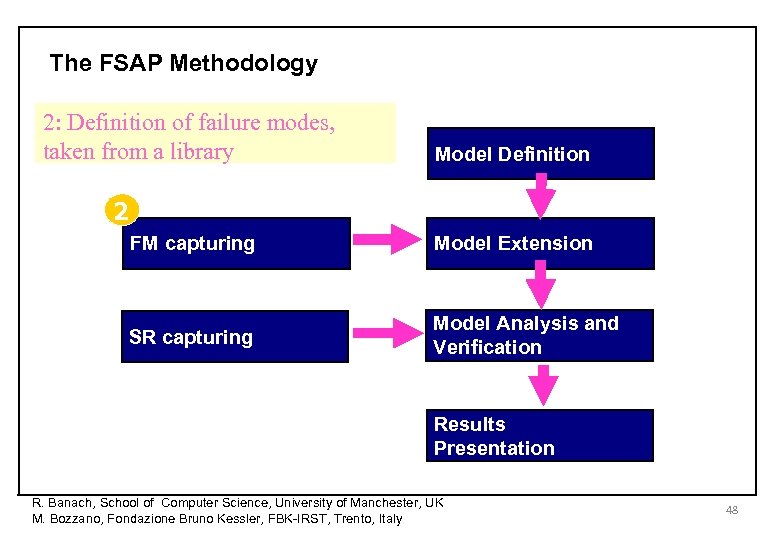 The FSAP Methodology 2: Definition of failure modes, taken from a library Model Definition 2 FM capturing Model Extension SR capturing Model Analysis and Verification Results Presentation R. Banach, School of Computer Science, University of Manchester, UK M. Bozzano, Fondazione Bruno Kessler, FBK-IRST, Trento, Italy 48
The FSAP Methodology 2: Definition of failure modes, taken from a library Model Definition 2 FM capturing Model Extension SR capturing Model Analysis and Verification Results Presentation R. Banach, School of Computer Science, University of Manchester, UK M. Bozzano, Fondazione Bruno Kessler, FBK-IRST, Trento, Italy 48
 The FSAP Methodology 3: Automatic model extension: Model Definition model + failure modes 3 FM capturing Model Extension SR capturing Model Analysis and Verification Results Presentation R. Banach, School of Computer Science, University of Manchester, UK M. Bozzano, Fondazione Bruno Kessler, FBK-IRST, Trento, Italy 49
The FSAP Methodology 3: Automatic model extension: Model Definition model + failure modes 3 FM capturing Model Extension SR capturing Model Analysis and Verification Results Presentation R. Banach, School of Computer Science, University of Manchester, UK M. Bozzano, Fondazione Bruno Kessler, FBK-IRST, Trento, Italy 49
 The FSAP Methodology 4: Definition of safety requirements Model Definition FM capturing 4 Model Extension SR capturing Model Analysis and Verification Results Presentation R. Banach, School of Computer Science, University of Manchester, UK M. Bozzano, Fondazione Bruno Kessler, FBK-IRST, Trento, Italy 50
The FSAP Methodology 4: Definition of safety requirements Model Definition FM capturing 4 Model Extension SR capturing Model Analysis and Verification Results Presentation R. Banach, School of Computer Science, University of Manchester, UK M. Bozzano, Fondazione Bruno Kessler, FBK-IRST, Trento, Italy 50
 The FSAP Methodology 5: Model verification, FTA, FMEA, … Model Definition FM capturing Model Extension SR capturing 5 Model Analysis and Verification Results Presentation R. Banach, School of Computer Science, University of Manchester, UK M. Bozzano, Fondazione Bruno Kessler, FBK-IRST, Trento, Italy 51
The FSAP Methodology 5: Model verification, FTA, FMEA, … Model Definition FM capturing Model Extension SR capturing 5 Model Analysis and Verification Results Presentation R. Banach, School of Computer Science, University of Manchester, UK M. Bozzano, Fondazione Bruno Kessler, FBK-IRST, Trento, Italy 51
 The FSAP Methodology 6: Display of results Model Definition FM capturing Model Extension SR capturing Model Analysis and Verification 6 Results Presentation R. Banach, School of Computer Science, University of Manchester, UK M. Bozzano, Fondazione Bruno Kessler, FBK-IRST, Trento, Italy 52
The FSAP Methodology 6: Display of results Model Definition FM capturing Model Extension SR capturing Model Analysis and Verification 6 Results Presentation R. Banach, School of Computer Science, University of Manchester, UK M. Bozzano, Fondazione Bruno Kessler, FBK-IRST, Trento, Italy 52
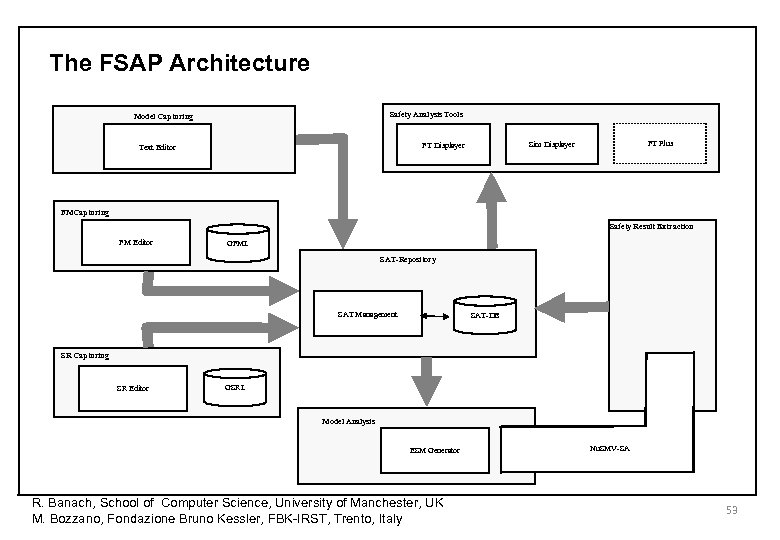 The FSAP Architecture Safety Analysis Tools Model Capturing FT Plus Sim Displayer FT Displayer Text Editor FMCapturing Safety Result Extraction FM Editor GFML SAT-Repository SAT Management SAT-DB SR Capturing SR Editor GSRL Model Analysis ESM Generator R. Banach, School of Computer Science, University of Manchester, UK M. Bozzano, Fondazione Bruno Kessler, FBK-IRST, Trento, Italy Nu. SMV-SA 53
The FSAP Architecture Safety Analysis Tools Model Capturing FT Plus Sim Displayer FT Displayer Text Editor FMCapturing Safety Result Extraction FM Editor GFML SAT-Repository SAT Management SAT-DB SR Capturing SR Editor GSRL Model Analysis ESM Generator R. Banach, School of Computer Science, University of Manchester, UK M. Bozzano, Fondazione Bruno Kessler, FBK-IRST, Trento, Italy Nu. SMV-SA 53
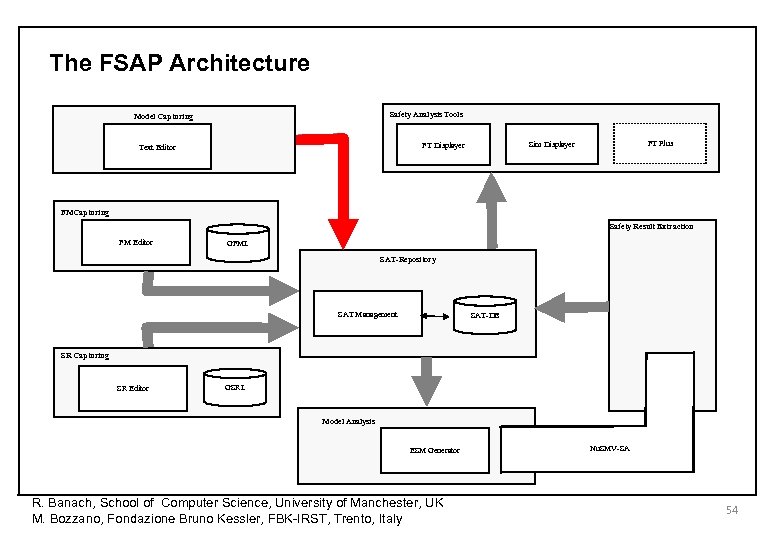 The FSAP Architecture Safety Analysis Tools Model Capturing FT Plus Sim Displayer FT Displayer Text Editor FMCapturing Safety Result Extraction FM Editor GFML SAT-Repository SAT Management SAT-DB SR Capturing SR Editor GSRL Model Analysis ESM Generator R. Banach, School of Computer Science, University of Manchester, UK M. Bozzano, Fondazione Bruno Kessler, FBK-IRST, Trento, Italy Nu. SMV-SA 54
The FSAP Architecture Safety Analysis Tools Model Capturing FT Plus Sim Displayer FT Displayer Text Editor FMCapturing Safety Result Extraction FM Editor GFML SAT-Repository SAT Management SAT-DB SR Capturing SR Editor GSRL Model Analysis ESM Generator R. Banach, School of Computer Science, University of Manchester, UK M. Bozzano, Fondazione Bruno Kessler, FBK-IRST, Trento, Italy Nu. SMV-SA 54
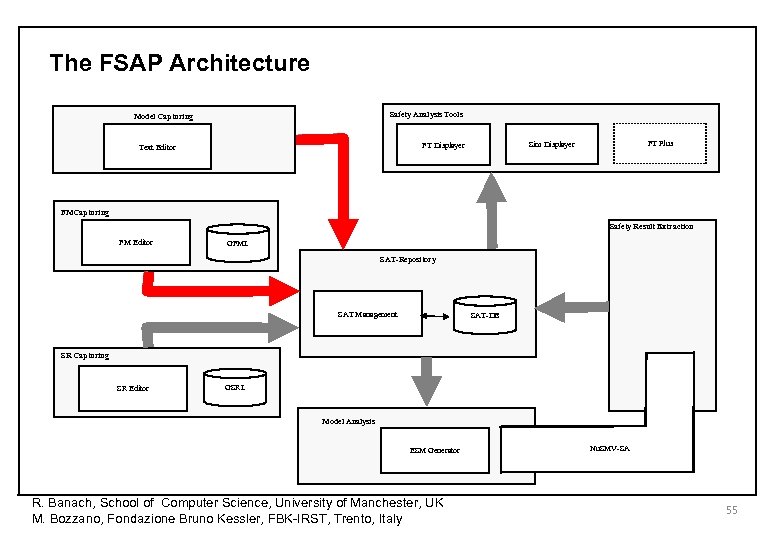 The FSAP Architecture Safety Analysis Tools Model Capturing FT Plus Sim Displayer FT Displayer Text Editor FMCapturing Safety Result Extraction FM Editor GFML SAT-Repository SAT Management SAT-DB SR Capturing SR Editor GSRL Model Analysis ESM Generator R. Banach, School of Computer Science, University of Manchester, UK M. Bozzano, Fondazione Bruno Kessler, FBK-IRST, Trento, Italy Nu. SMV-SA 55
The FSAP Architecture Safety Analysis Tools Model Capturing FT Plus Sim Displayer FT Displayer Text Editor FMCapturing Safety Result Extraction FM Editor GFML SAT-Repository SAT Management SAT-DB SR Capturing SR Editor GSRL Model Analysis ESM Generator R. Banach, School of Computer Science, University of Manchester, UK M. Bozzano, Fondazione Bruno Kessler, FBK-IRST, Trento, Italy Nu. SMV-SA 55
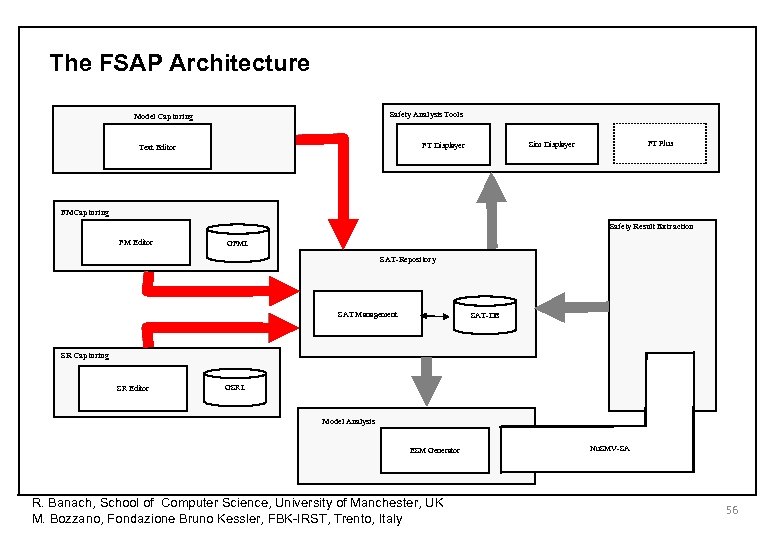 The FSAP Architecture Safety Analysis Tools Model Capturing FT Plus Sim Displayer FT Displayer Text Editor FMCapturing Safety Result Extraction FM Editor GFML SAT-Repository SAT Management SAT-DB SR Capturing SR Editor GSRL Model Analysis ESM Generator R. Banach, School of Computer Science, University of Manchester, UK M. Bozzano, Fondazione Bruno Kessler, FBK-IRST, Trento, Italy Nu. SMV-SA 56
The FSAP Architecture Safety Analysis Tools Model Capturing FT Plus Sim Displayer FT Displayer Text Editor FMCapturing Safety Result Extraction FM Editor GFML SAT-Repository SAT Management SAT-DB SR Capturing SR Editor GSRL Model Analysis ESM Generator R. Banach, School of Computer Science, University of Manchester, UK M. Bozzano, Fondazione Bruno Kessler, FBK-IRST, Trento, Italy Nu. SMV-SA 56
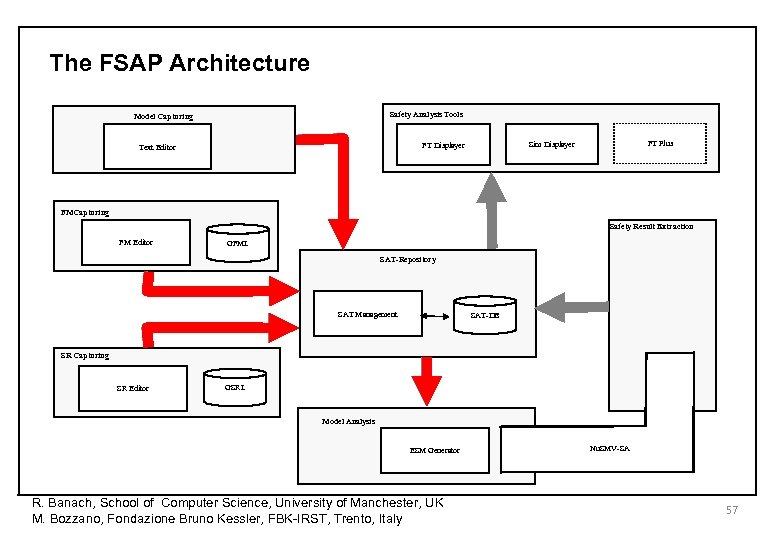 The FSAP Architecture Safety Analysis Tools Model Capturing FT Plus Sim Displayer FT Displayer Text Editor FMCapturing Safety Result Extraction FM Editor GFML SAT-Repository SAT Management SAT-DB SR Capturing SR Editor GSRL Model Analysis ESM Generator R. Banach, School of Computer Science, University of Manchester, UK M. Bozzano, Fondazione Bruno Kessler, FBK-IRST, Trento, Italy Nu. SMV-SA 57
The FSAP Architecture Safety Analysis Tools Model Capturing FT Plus Sim Displayer FT Displayer Text Editor FMCapturing Safety Result Extraction FM Editor GFML SAT-Repository SAT Management SAT-DB SR Capturing SR Editor GSRL Model Analysis ESM Generator R. Banach, School of Computer Science, University of Manchester, UK M. Bozzano, Fondazione Bruno Kessler, FBK-IRST, Trento, Italy Nu. SMV-SA 57
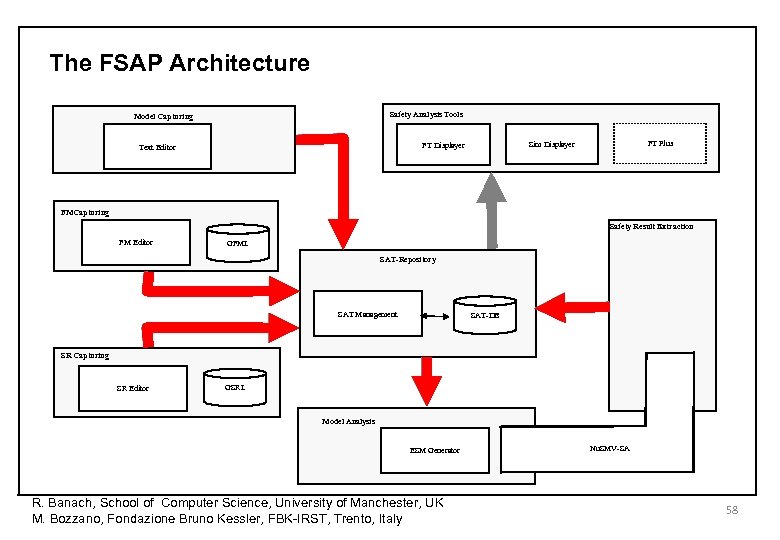 The FSAP Architecture Safety Analysis Tools Model Capturing FT Plus Sim Displayer FT Displayer Text Editor FMCapturing Safety Result Extraction FM Editor GFML SAT-Repository SAT Management SAT-DB SR Capturing SR Editor GSRL Model Analysis ESM Generator R. Banach, School of Computer Science, University of Manchester, UK M. Bozzano, Fondazione Bruno Kessler, FBK-IRST, Trento, Italy Nu. SMV-SA 58
The FSAP Architecture Safety Analysis Tools Model Capturing FT Plus Sim Displayer FT Displayer Text Editor FMCapturing Safety Result Extraction FM Editor GFML SAT-Repository SAT Management SAT-DB SR Capturing SR Editor GSRL Model Analysis ESM Generator R. Banach, School of Computer Science, University of Manchester, UK M. Bozzano, Fondazione Bruno Kessler, FBK-IRST, Trento, Italy Nu. SMV-SA 58
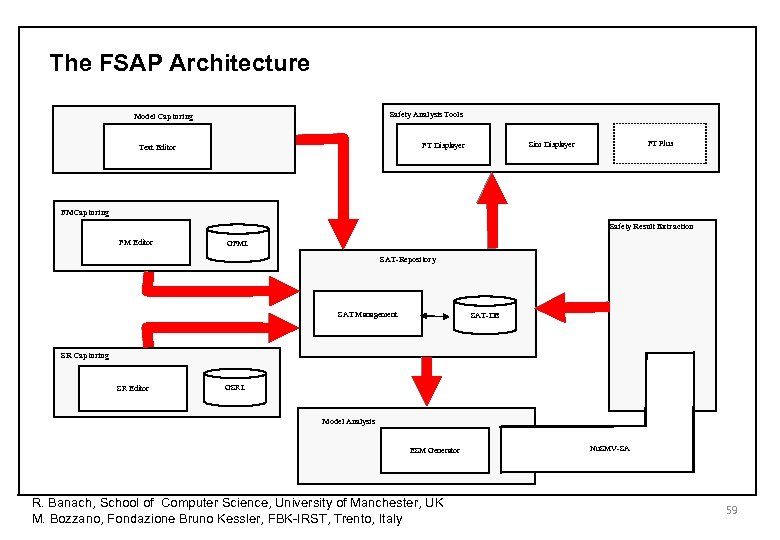 The FSAP Architecture Safety Analysis Tools Model Capturing FT Plus Sim Displayer FT Displayer Text Editor FMCapturing Safety Result Extraction FM Editor GFML SAT-Repository SAT Management SAT-DB SR Capturing SR Editor GSRL Model Analysis ESM Generator R. Banach, School of Computer Science, University of Manchester, UK M. Bozzano, Fondazione Bruno Kessler, FBK-IRST, Trento, Italy Nu. SMV-SA 59
The FSAP Architecture Safety Analysis Tools Model Capturing FT Plus Sim Displayer FT Displayer Text Editor FMCapturing Safety Result Extraction FM Editor GFML SAT-Repository SAT Management SAT-DB SR Capturing SR Editor GSRL Model Analysis ESM Generator R. Banach, School of Computer Science, University of Manchester, UK M. Bozzano, Fondazione Bruno Kessler, FBK-IRST, Trento, Italy Nu. SMV-SA 59
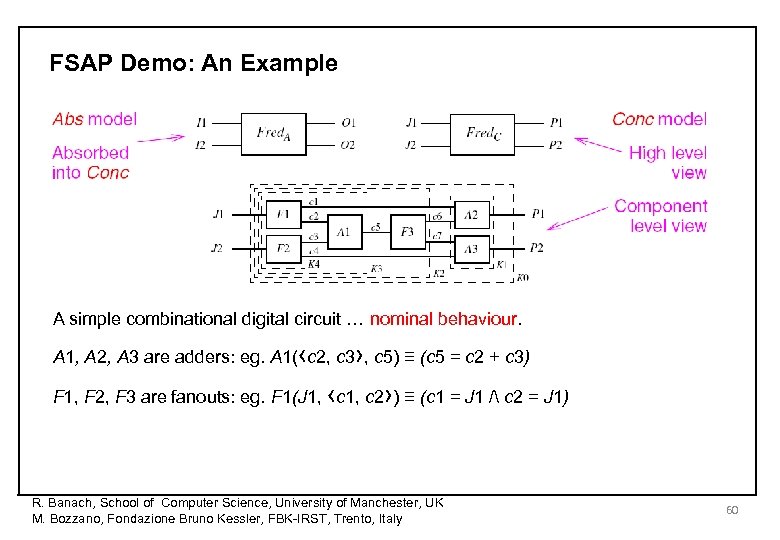 FSAP Demo: An Example A simple combinational digital circuit … nominal behaviour. A 1, A 2, A 3 are adders: eg. A 1(‹c 2, c 3›, c 5) ≡ (c 5 = c 2 + c 3) F 1, F 2, F 3 are fanouts: eg. F 1(J 1, ‹c 1, c 2›) ≡ (c 1 = J 1 / c 2 = J 1) R. Banach, School of Computer Science, University of Manchester, UK M. Bozzano, Fondazione Bruno Kessler, FBK-IRST, Trento, Italy 60
FSAP Demo: An Example A simple combinational digital circuit … nominal behaviour. A 1, A 2, A 3 are adders: eg. A 1(‹c 2, c 3›, c 5) ≡ (c 5 = c 2 + c 3) F 1, F 2, F 3 are fanouts: eg. F 1(J 1, ‹c 1, c 2›) ≡ (c 1 = J 1 / c 2 = J 1) R. Banach, School of Computer Science, University of Manchester, UK M. Bozzano, Fondazione Bruno Kessler, FBK-IRST, Trento, Italy 60
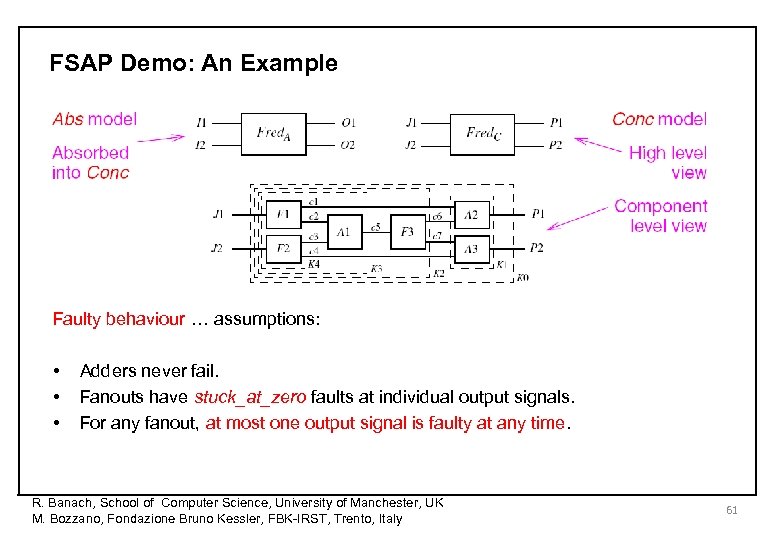 FSAP Demo: An Example Faulty behaviour … assumptions: • • • Adders never fail. Fanouts have stuck_at_zero faults at individual output signals. For any fanout, at most one output signal is faulty at any time. R. Banach, School of Computer Science, University of Manchester, UK M. Bozzano, Fondazione Bruno Kessler, FBK-IRST, Trento, Italy 61
FSAP Demo: An Example Faulty behaviour … assumptions: • • • Adders never fail. Fanouts have stuck_at_zero faults at individual output signals. For any fanout, at most one output signal is faulty at any time. R. Banach, School of Computer Science, University of Manchester, UK M. Bozzano, Fondazione Bruno Kessler, FBK-IRST, Trento, Italy 61
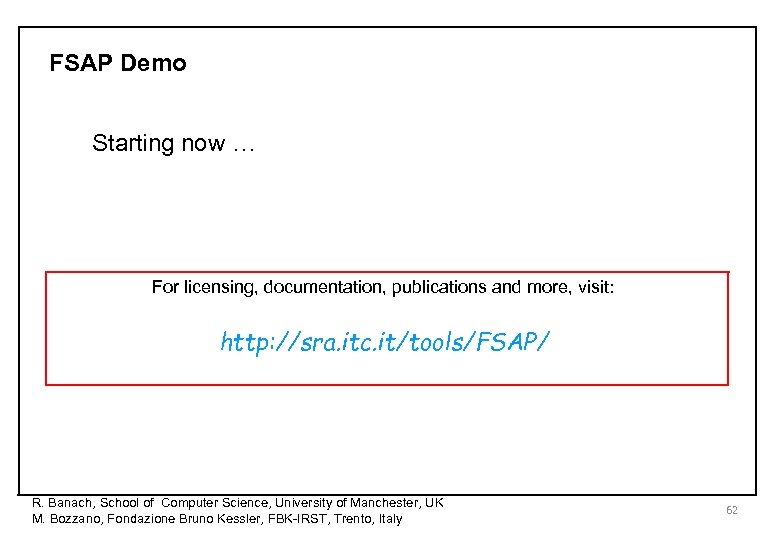 FSAP Demo Starting now … For licensing, documentation, publications and more, visit: http: //sra. itc. it/tools/FSAP/ R. Banach, School of Computer Science, University of Manchester, UK M. Bozzano, Fondazione Bruno Kessler, FBK-IRST, Trento, Italy 62
FSAP Demo Starting now … For licensing, documentation, publications and more, visit: http: //sra. itc. it/tools/FSAP/ R. Banach, School of Computer Science, University of Manchester, UK M. Bozzano, Fondazione Bruno Kessler, FBK-IRST, Trento, Italy 62


